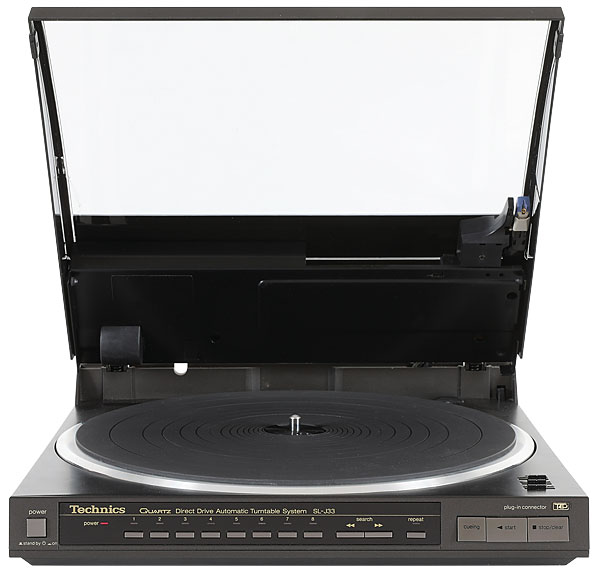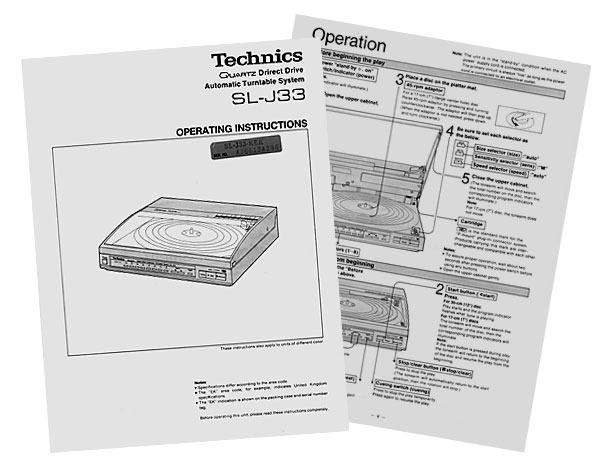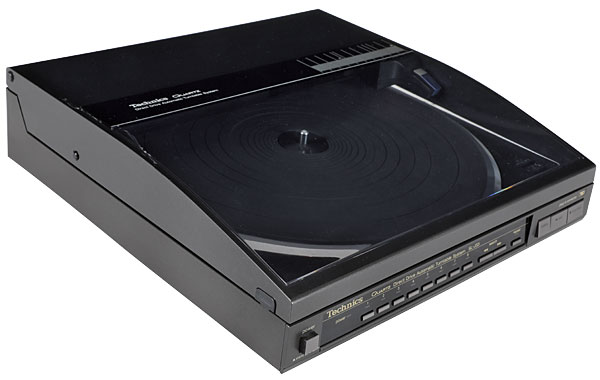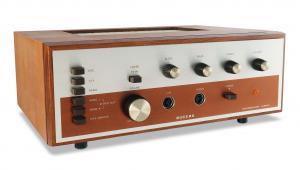Technics SL-J33 turntable Page 2
My only criticism is that the delay before the music starts after the arm has been set down can be frustratingly long due to the action of the muting system. The manual states 'about ten seconds', but sometimes it seems much more!
![]() Tim Listens
Tim Listens
Despite being regarded with more than a little suspicion by a number of my audiophile friends, the Technics SL-J33 revealed itself to be an excellent turntable in my listening tests. However, as with the SL-10, it proved to be sensitive to positioning. That TNRC base aside, the sprung rubber feet do not provide much in the way of isolation while the lid, being somewhat lighter and less stiff than the one used for the SL-10, can also pick up airborne vibrations and direct them towards the cartridge. So setting the turntable up in a well sheltered location in the listening room is recommended.

After the deck had been loaded and scanned, I punched up 'The Logical Song', which is the second track on Supertramp's 1979 album Breakfast In America [A&M AMLK 63708]. The deck as a whole put in a predictably bright and punchy performance while the EPC-P30 pick-up tracked securely, delivering a pleasing tonal balance even during the song's more energetic sections.
However, what really impressed the most was the way in which cymbals retained their clarity even when there was a great deal else going on in the mix. I've known many a lesser turntable to stumble at this point. Indeed, I had braced myself for the sort of hard, splashy treble one usually hears from basic cartridges, but the problem never arose. Yes, the presentation can sound a tad well-lit, but a nice plump bassline helps to balance this off.
Meanwhile, issues such as speed stability and bearing rumble, which are determined by the performance of the motor, were as good as they ever need to be. In this area the Technics SL-J33 was an impressive machine.

A more exacting challenge was set by Mussorgsky's Pictures At An Exhibition [Victor LSC-2201]. Filled with sustained notes, long silences and sudden bursts of energy and excitement, it is the ideal recording to explore the limits of turntable performance. The first of these challenges poses no problem to a Technics direct-drive deck, but would the silences expose the SL-10 bugbear of a bump-thump noise coming from the tracking motor?
To a point, yes. The noise is still there but in greatly reduced form. This is one key improvement over the older design, though I did get the impression that the SL-10 could produce greater depth in its soundstage than the SL-J33 can.
With the EPC-P30 pick-up fitted, the effect seemed to be that of a strip of sound, extending well beyond the loudspeakers but lacking in perceived space vertically as well as fore and aft. It is an odd observation, but I was aware of it over a wide range of material.
Full Measure
Returning to Mussorgsky, the bright sound of the SL-J33 highlighted the record's surface noise during the various musical silences in a way that, for example, the big B&O linear-tracking decks don't. It is easy to obsess about such things when the music is soft, such as at the close of the first 'Promenade'. However, as the whole orchestra springs to life at the opening of 'Gnomus', an event given its full measure of vitality by the little Technics deck, the large dynamic range of this piece puts this little problem more into perspective.

Refined though it is, the SL-J33 is a modest fit for the hobby of 'hi-fi' (as opposed to that of listening to records, for which it is very useful indeed). Those who enjoy visual drama and delicate manual interactions as part of their listening experience will find it lacking, as it makes spinning a record no more involving than playing a CD. It won't impress your friends much at your next dinner party either, which if the styling of many modern turntables is anything to go by, is an important consideration for many – and rightly so! Nevertheless, the Technics SL-J33 is ever so good at turning those funny little squiggles on the surface of a record back into music. I'm convinced. I'm sure you will be too.
Buying Secondhand
For such a complex product, the SL-J33 has proved to be remarkably reliable in service, but after over 30 years of use some common problems are beginning to emerge. Failure of the arm to move correctly (or at all), often accompanied by the noise of a frantically spinning motor at the lefthand rear corner of the lid, points to a worn belt in the arm drive system. Replacement is straightforward so long as the new belt and the pulleys it runs on are kept free from the copious amounts of lubricant that the factory usually applied in this area.

The track-finding system can become erratic with age, under-counting the number of tracks or not registering any at all – even with the sensitivity switch at its highest setting. The cause of this is the ageing of the LED in the arm sensor but in most cases the original performance can be restored by performing the 'sensor gain adjustment' procedure that you'll find detailed in the service manual.
Similarly, failure of the muting system to fully blank the end of the previous track before the desired selection starts can usually be resolved by cleaning the muting relay. Faults with the main motor are rare, but when they do occur, check that the centre spindle rotates freely before delving deep into the electronics.
Finally, as with the Technics SL-10, an Audio-Technica AT-85EP makes a good upgrade/replacement for the original EPC-P30 cartridge and does not disrupt the working of the track-finding system.
Hi-Fi News Verdict
Don't let its humble looks put you off, for the Technics SL-J33 has the best track-search system of any turntable I've ever used, and that it plays the tracks it finds to such a high standard is more than a pleasant surprise. Just pipped by the older SL-10 in terms of atmosphere, it is still capable of a level of performance that belies its ease of use and current low price on the secondhand market. I'm keeping this one!























































